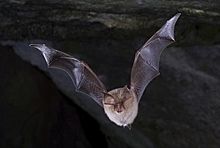Caerwood and Ashberry Goose House facts for kids
| Site of Special Scientific Interest | |

Example - Lesser Horseshoe Bat (Rhinolophus hipposideros)
|
|
| Area of Search | Gloucestershire |
|---|---|
| Grid reference | & |
| Coordinates | 51°39′57″N 2°39′22″W / 51.665937°N 2.656165°W |
| Interest | Biological |
| Area | 0.01 hectare |
| Notification | 1991 |
Caerwood And Ashberry Goose House is a very special place in Gloucestershire, England. It is a Site of Special Scientific Interest (SSSI). This means it's protected because of its important wildlife. It became an SSSI in 1991. This special area is located in the beautiful Wye Valley, which is also an Area of Outstanding Natural Beauty.
Contents
Why is this place special?
This site is super important for Lesser horseshoe bats. It's one of only three places in Gloucestershire where these bats have their babies. The site is found at the top of the wooded hills of the Wye Valley. It's also at the very south end of the Forest of Dean.
Bats of the Wye Valley
Caerwood And Ashberry Goose House is part of a group of SSSIs in the Forest of Dean and Wye Valley. These sites together provide homes for both Lesser and Greater horseshoe bats. These bats are very important across Europe!
Other special bat sites in Gloucestershire include:
- Breeding sites:
- Winter hibernation sites:
The Forest of Dean and Wye Valley have lots of trees and sheltered valleys. This makes them great places for bats to find food. The old mines and caves underground are perfect spots for bats to rest and raise their young.
European Importance
The Wye Valley and Forest of Dean Bat Sites are so important that they are called a Special Area of Conservation (SAC). This is a special protection under European rules for wildlife.
What kind of space do the bats use?
The bats at Caerwood And Ashberry Goose House use the roof spaces of two buildings. They use these spaces during certain times of the year as "nursery roosts." A nursery roost is where mother bats gather to have and raise their pups.
It looks like bats have been using this site for over 50 years! Besides the Lesser horseshoe bats, Pipistrelle bats (Pipistrellus pipistrellus) also use this site as a nursery.

